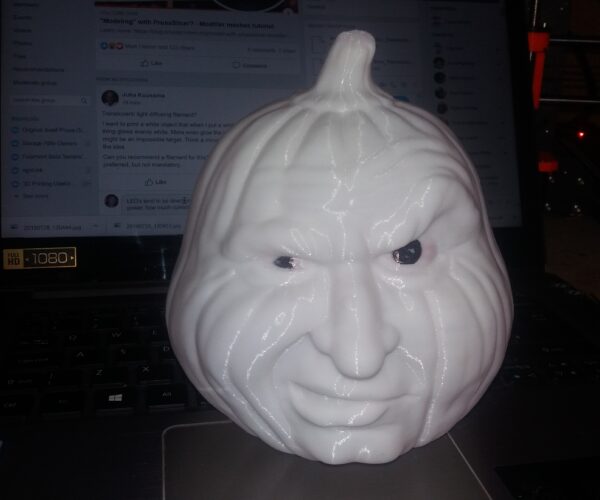For which kind of objects is „vase mode“/„spiral vase“ good? (despite a spiral vase itself)
Never used it so far and wondering what it does??
And for which purpose or object I should use this "vases mode"/"spiral vase".
One of the forum users wanted a single perimeter, lamp Globe, for a "Back to the future" display.
the original had been modelled as a hollow model, and the user wanted it to be a vase mode single wall model.
you cannot print a hollow model as vase mode, so I had to re model it as a solid model, then use Vase Mode, to print it... but to add complication, the user wanted no bottom layers on the model because they wanted to illuminate the globe through the bottom.
I added a brim, to ensure adhesion (Easily removable after the print was complete)
for another print, I made a grumpy pumpkin lantern! also using vase mode...
in both instances I raised the extrusion width, to add strength to the single wall print!.
regards Joan
I try to make safe suggestions,You should understand the context and ensure you are happy that they are safe before attempting to apply my suggestions, what you do, is YOUR responsibility.Location Halifax UK
?
They look great!
But I still don't get it ...what is the purpose of this vase mode setting? What does it do differently than the regular setting?
One continuous extrusion avoids z-seam scarring
[...] But I still don't get it ...what is the purpose of this vase mode setting? What does it do differently than the regular setting?
It prints as one continuous extrusion rather than discrete layers. If you were to print a model with 1 perimeter, you'd get much the same effect, but every layer would have the z-seam created when the extrusion stops and the nozzle is lifted to the next layer. On cylindrical prints, this creates a visible scar. Vase mode avoids this by never stopping the flow of filament. Unfortunately, it only works for things that can be printed in one continuous motion like vases, poles and the like.
and miscellaneous other tech projects
He is intelligent, but not experienced. His pattern indicates two dimensional thinking. -- Spock in Star Trek: The Wrath of Khan
RE: A single wall, no infill
Not every model will be printable in vase mode, but here are three advantages. There is a single wall and no infill which allows more light to pass through the print which is ideal for lampshades or even vases printed with transparent filament. Another advantage is that without any infill or internal structure, the print is exceedingly light weight. The third is a shorter printing time and less filament used.
Mk3S+,SL1S
print goes in spiral, not layers
There is one strong benefit. In regular print every layer print starts and ends somewhere. On that place you can find small mistakes of extra material or missing material. In vase mode there is no layer change, it goes up in a spiral, so continuously without starting and ending layer. For circular objects the print is much cleaner. Squared objects can hide those "seeds" in the cornes, but with circular objects you can definitelly see that.